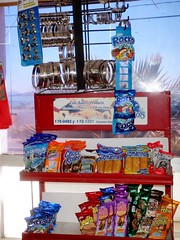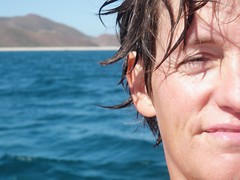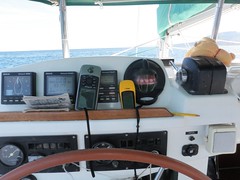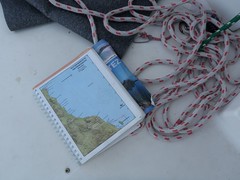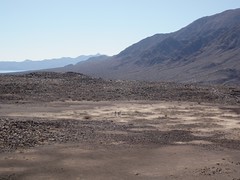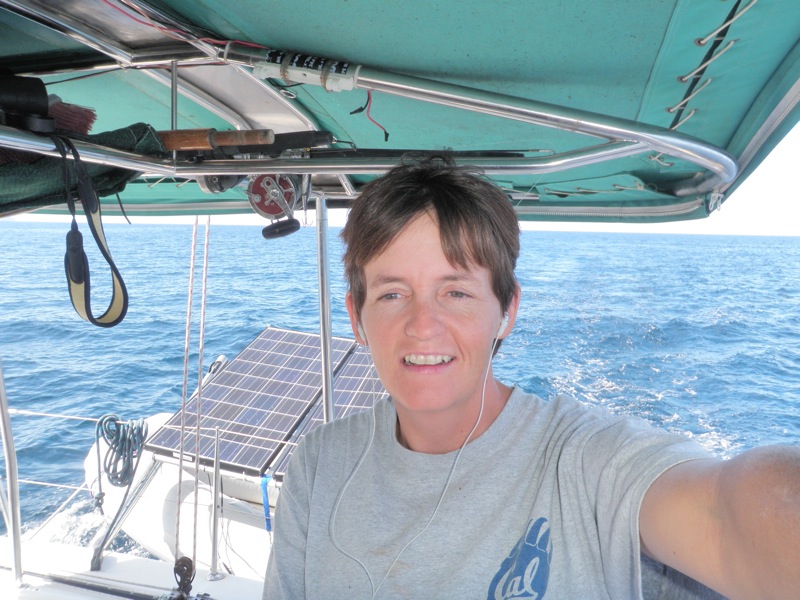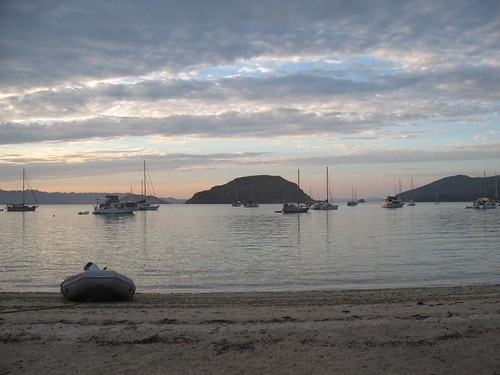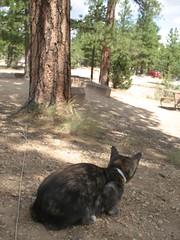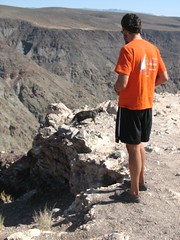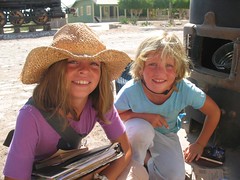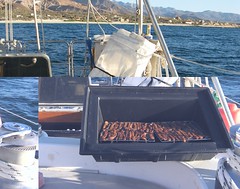Cruisers can live in Mexico for years and never learn a word of Spanish. Finger pointing and other gestures combined with grunts and a surprisingly wide-spread knowledge of English even amongst your average street vendor combine to make it pretty easy to let your Spanish lessons lapse. You could hang out exclusively with other Americans and Canadians, shop at the large commercial supermarkets, and use a friend to help you with the occasional mechanic and never learn more Spanish than hola and adios.
However, I’m going to recommend that you make the effort to learn Spanish anyway. Learn at least the most useful few hundred words and phrases that differentiate the Ugly American from a savvy experienced traveler making the most of an experience abroad. You don’t have to speak it well. You don’t even have to understand what you are saying. What you must do is look like you’re trying.
In my professional life, I frequently consult for companies who are writing English language documentation destined for either an international, English as a Second Language (ESL) audience or for translation into multiple languages. In both cases, a key to reducing cost and improving usability is to restrict the source documentation to a simple, stripped down version of the English language. Instead of drawing upon the upwards of 30,000 words in our native tongue, I help clients identify the roughly 2,000 words they need to communicate every important concept, feature and task required of their product. For each industry, this core simplified English dictionary varies somewhat with roughly a third being industry specific and ten percent unique to the client or product.
But think about that. A mere 2,000 words is all that is needed to convey the most sophisticated of concepts in industries as diverse as airplane manufacture, medicine, or network security. When it comes to “simplified cruiser Spanish,” you could master everything you need to know by adding 20 words or phrases to your vocabulary every week for two years.
This is how the crew of Don Quixote is learning Spanish. We tried Rosetta Stone and school books. We did online programs, coloring books, little signs on everything on the boat. Nothing really stuck with either the girls or myself. Finally, I got smart. The very trick I have successfully implemented in company after company would work here. For us. In Mexico. We needed 2,000 words of cruiser Spanish, and we needed to learn them a little bit every week as the words became important to us. This would help us “mine” our lives for the appropriate palette of words and give us many opportunities to use the new words each week.
We began with a week of food. Followed by another week of restaurant. Then we did a week of more food. This family moves on its stomach. We pulled into Santa Rosalia for the first time and realized we needed a week of dock terms, then another week of town terms, and right before we left in the van, a week of traveling words. We returned to suck down two weeks of words in three days relating to wind, weather, hurricanes, forecasting, and tides. Then we drifted on our laurels for a few weeks slowly taking in boat parts, clothing, colors, and birthday words. Last week DrC insisted it was time I learned 20 words relating to sex, and so I felt compelled to give the girls their own list of non-related phrases having to do with holidays and cleaning tools. With relatives headed down in the coming weeks, we’ll tackle relationships, travel on planes, and words needed in thank you letters to grandparents.
This slow accretion of words and phrases is working. My accent is absolutely awful, but daily I find myself using my Spanish more, with increased comfort and confidence. The Mexicans laugh with me when I say bird beak (pronounced pee-ko) rather than small (poh-koh), but they appreciate the effort. Each day, a vendor teaches me a new word such as poblano (chile used for chile rellenos) or tornillo de ferrous inoxidable (stainless steel screws). Each day, my grasp of cruiser Spanish grows, and I am more comfortable moving around in Mexican markets and ferreterias (hardware stores).
Knowing the language in the country through which you travel makes good sense. You are safer. You are stronger. You are more courteous. Your depth of understanding of the people and culture you are encountering is considerably greater. Just because you can travel in Mexico without learning the language, doesn’t mean you should. If you are planning a trip to French Polynesia or Latin America, start now. Two thousand is just not a very large number.
Saturday, November 28, 2009
Tuesday, November 24, 2009
You Break It, You Bought It
Editor's Note: Written during our Summer Without Daddy up in Bahia de Los Angeles.
DrC has left us alone before. Twice in fact. The first time he left us for a month to work, he planted us in Port McNeil on Vancouver Island. We spent our time going on hikes, swimming in the local pool, visiting the library, and studying. Twice, we pulled the anchor and went on a brief foray over to Alert Bay. Basically, we didn't move and nothing broke.
The second time DrC was forced to work, he left us in Zihautenejo. We hardly moved the boat at all during that visit, but we were more adventurous in other ways. We explored Zihua and Ixtapa, participated in the Zihua Sail Fest '09, and became entwined in the lives of several cruisers. This is where we met Uncle Glenn, adventured with Bay Wolf to Ixtapa, and managed to get ourselves invited to just about every gringo hotel pool within 50 miles. The month zipped by very rapidly and pleasurably, though I'll grant you for the most part we didn't move and nothing broke.
This third – and final – extended period of DrC working time was completely different. For one thing, it was actually two months broken in the middle by a month spent on a road trip with daddy in the States. DrC left in June and didn't return until October. For another, hurricane season necessitated that we motor the boat a good long distance from Santa Rosalia up 130 miles north to the Bahia de Los Angeles area.
This time, we had to move. This time, everything broke. I don't know if the two issues are related. Had we moved the first two times DrC was not on the boat, it's possible everything would have stayed together. It's also possible that leaving the boat for a month then having the thing ride out Hurricane Jimena contributed to the delinquency of our minor boat. Whatever the causes, the effect was almost daily breakage – an endless series of more or less panicky mechanical crises during which I had to simultaneously fix the diesel engines and maintain my spotless nail care regime.
Okay, that last bit is a lie. I don't have a nail care regime. On the other hand, I also know precisely nothing about diesel mechanics.
Or knew precisely nothing. Now I know something. I know how to fix a frozen throttle and how to prime the raw water system. I know that the impellers can get squashed and need to be replaced regularly and that the little black belt thingie around the end of the water pump shouldn't be loose. There's a sea cock for the sail drive, and the raw water strainer has plastic fittings that break if you are not super careful. There is also a little light for the engine room that magically turns itself on and runs down the batteries, and there are two extra switches in the port which have nothing to do with the engines and are used exclusively for the water maker.
Other gems I've picked up. Salt water rusts things. Fresh water does not make the rust stop rusting. Don't get lubricant on your belts. Don't stand on the heat exchanger in your bare feet. Metal hose clamps are made of the world's sharpest metal and will shred your hands. My husband keeps all the tools in the starboard bow in a series of boxes. The item you want will always be in the box on the bottom of the pile. There are three manuals to go through every time you want to touch the diesels; Calder's will be the most thorough but completely inexplicable while the Yanmar shop manual has the most useful pictures and the most poorly written instructions.
In the cruising community, pink and blue are well established. It's not really sexism or misogyny, it's just practical. There is too much to learn on a boat so the world gets divided. Using traditional gender roles isn't much of a stretch. At potlucks, guys stand in a circle with beers in hand discussing motors, mounts, tools, and electrolysis. They remind me of scenes at the fraternities at Cal Berkeley just 30 years older and missing the signature keg. The women gather around tables and at picnic blankets. Their conversation, mind you, is just as technical but involves navigation, provisioning, timing weather, and radio nets. Those are the pink jobs. During my summer of breakage, I would shuttle back and forth all night. I needed the weather info, but I also needed to know how to fix the port raw water system.
In both camps, the support was profound and reassuring. The men welcomed my presence and willingly answered my basic and often quite stupid questions. The women were admiring, praising my courage. But I'm not courageous. It is not heroic. There are many single handers out here who handle all the jobs, pink and blue. There are even a few who do it with children. If I hadn't known there were a hard stop in a few weeks when DrC arrived back from the States, I don't know how I would have pulled myself together and kept going. Also, I didn't always handle the breakage gracefully. I cried one time the port raw water system stopped working. After hours of popping in and out of the transom, my back started to hurt, and I got very snippy with the girls. I'm not actually good at this.
But I did it. I fixed engines and water systems, the water maker and the outboard, the deck light, the starboard head and the port bilge pump. Every day we cleaned the boat, we finished our school, and we moved to the next anchorage. We provisioned, we made bread, and we ate it. All the work got done even without the girls' incredibly capable daddy.
So the message to the girls must be the right one. It's okay to be girly, to sigh and to cry and to get frustrated. It's not okay to be helpless.
DrC has left us alone before. Twice in fact. The first time he left us for a month to work, he planted us in Port McNeil on Vancouver Island. We spent our time going on hikes, swimming in the local pool, visiting the library, and studying. Twice, we pulled the anchor and went on a brief foray over to Alert Bay. Basically, we didn't move and nothing broke.
The second time DrC was forced to work, he left us in Zihautenejo. We hardly moved the boat at all during that visit, but we were more adventurous in other ways. We explored Zihua and Ixtapa, participated in the Zihua Sail Fest '09, and became entwined in the lives of several cruisers. This is where we met Uncle Glenn, adventured with Bay Wolf to Ixtapa, and managed to get ourselves invited to just about every gringo hotel pool within 50 miles. The month zipped by very rapidly and pleasurably, though I'll grant you for the most part we didn't move and nothing broke.
This third – and final – extended period of DrC working time was completely different. For one thing, it was actually two months broken in the middle by a month spent on a road trip with daddy in the States. DrC left in June and didn't return until October. For another, hurricane season necessitated that we motor the boat a good long distance from Santa Rosalia up 130 miles north to the Bahia de Los Angeles area.
This time, we had to move. This time, everything broke. I don't know if the two issues are related. Had we moved the first two times DrC was not on the boat, it's possible everything would have stayed together. It's also possible that leaving the boat for a month then having the thing ride out Hurricane Jimena contributed to the delinquency of our minor boat. Whatever the causes, the effect was almost daily breakage – an endless series of more or less panicky mechanical crises during which I had to simultaneously fix the diesel engines and maintain my spotless nail care regime.
Okay, that last bit is a lie. I don't have a nail care regime. On the other hand, I also know precisely nothing about diesel mechanics.
Or knew precisely nothing. Now I know something. I know how to fix a frozen throttle and how to prime the raw water system. I know that the impellers can get squashed and need to be replaced regularly and that the little black belt thingie around the end of the water pump shouldn't be loose. There's a sea cock for the sail drive, and the raw water strainer has plastic fittings that break if you are not super careful. There is also a little light for the engine room that magically turns itself on and runs down the batteries, and there are two extra switches in the port which have nothing to do with the engines and are used exclusively for the water maker.
Other gems I've picked up. Salt water rusts things. Fresh water does not make the rust stop rusting. Don't get lubricant on your belts. Don't stand on the heat exchanger in your bare feet. Metal hose clamps are made of the world's sharpest metal and will shred your hands. My husband keeps all the tools in the starboard bow in a series of boxes. The item you want will always be in the box on the bottom of the pile. There are three manuals to go through every time you want to touch the diesels; Calder's will be the most thorough but completely inexplicable while the Yanmar shop manual has the most useful pictures and the most poorly written instructions.
In the cruising community, pink and blue are well established. It's not really sexism or misogyny, it's just practical. There is too much to learn on a boat so the world gets divided. Using traditional gender roles isn't much of a stretch. At potlucks, guys stand in a circle with beers in hand discussing motors, mounts, tools, and electrolysis. They remind me of scenes at the fraternities at Cal Berkeley just 30 years older and missing the signature keg. The women gather around tables and at picnic blankets. Their conversation, mind you, is just as technical but involves navigation, provisioning, timing weather, and radio nets. Those are the pink jobs. During my summer of breakage, I would shuttle back and forth all night. I needed the weather info, but I also needed to know how to fix the port raw water system.
In both camps, the support was profound and reassuring. The men welcomed my presence and willingly answered my basic and often quite stupid questions. The women were admiring, praising my courage. But I'm not courageous. It is not heroic. There are many single handers out here who handle all the jobs, pink and blue. There are even a few who do it with children. If I hadn't known there were a hard stop in a few weeks when DrC arrived back from the States, I don't know how I would have pulled myself together and kept going. Also, I didn't always handle the breakage gracefully. I cried one time the port raw water system stopped working. After hours of popping in and out of the transom, my back started to hurt, and I got very snippy with the girls. I'm not actually good at this.
But I did it. I fixed engines and water systems, the water maker and the outboard, the deck light, the starboard head and the port bilge pump. Every day we cleaned the boat, we finished our school, and we moved to the next anchorage. We provisioned, we made bread, and we ate it. All the work got done even without the girls' incredibly capable daddy.
So the message to the girls must be the right one. It's okay to be girly, to sigh and to cry and to get frustrated. It's not okay to be helpless.
Friday, November 20, 2009
Attention Span of a Housefly
I suffer from attention deficit split disorder (ADSDO, pronounced “ads do”). This is not a real syndrome; it is not recognized by the medical establishment. In fact, the term was coined by Mera. It is a mental pathology that manifests itself in an inability to do only one thing at a time. When my girls are working on math while simultaneously listening to Weird Al, painting their toenails orange and blue, and finger knitting, they explain that ADSDO is an inherited disease -- they get it from their mother.
The parent in me wants to scream in frustration, “Get your schoolwork done. FOCUS!” However, the unschooler wannabe idealist angel sitting on my other shoulder is smug. The girls are apparently reasonably well versed in the concepts of genetics and inheritance as well as the role of genes in disease. After a brief familial tussle in which I insist all three prove they can spell ADSDO and use it correctly in a sentence, I give up the struggle with only a token intervention in the form of putting towels under the nails.
Actually, my ADSDO is probably an adaptation to a mild form of the real thing -- attention hyperactivity disorder (ADHD). Back in the days before ritalin, bright kids with no ability to focus in class were tracked into either one of two programs: Semi-Permanent Detention or Mentally Gifted Minds. I found it peculiarly appropriate that at my elementary school, the detention hall shared the same room with the MGM program. From the distance of 30 years, I can see that the room should have had a sign warning teachers -- Abandon Patience All Ye Who Enter Here. It was the room for children who simply couldn’t be wrapped up, set in a row, and expected to sit still until recess.
Yet the traits that made me such a miserably poor excuse for an elementary student were also the very attributes of my personality which made me a highly successful manager: adaptive context switching, multi-threading, laser focus for brief periods of high intensity effort followed by intuitive decision making and moving on without regret or self-contemplation. In algebra, they accused me of cheating because I “skipped the steps” and simply wrote down the answer. In college, they took off points for “failure to show your work.” In business, they promoted me and gave me more people to manage... proving once again that academic success is a poor way to identify quality employees.
Problematically, the cruising life doesn’t offer enough things to do simultaneously to satisfy my housefly brain. In fact, traveling by sail for hundreds of miles is proving tantamount to locking me in a small white box, removing all the sharp objects, and playing an elevator version of Smells Like Teen Spirit. I can almost handle the monotony while motoring. I line my toys up on the helm: GPS, radar, chart plotter, cruising manual, anemometer, VHF radio, knot meter, and depth sounder. Then I pull out my iPod chock o'block full of podcasts and audio books as well as a pencil and book of sudoku. Between the steady stream of info bits, the logical complexity of the puzzle at the Avanzado and Experto levels, and a regular scan of instruments and horizon, my brain almost settles into a peaceful steady state.
However, the whole strategy falls apart when the seas are running high. First off, DrC likes to take the helm when we've got big wind and big wave in combination. He does this primarily because he likes to sail. He really enjoys it. He enjoys it more when everything is slightly edgy, big and heavy, weather helm and slop making the auto-pilot a dicey proposition and manually steering pretty much a necessity. So I get booted off the helm and into the salon.
Then we get to the second problem which is with the boat rolling around like a marble on a wooden maze game, my stomach and my head begin a futile tussle for dominance. The longer we're out, of course, the less this is a problem. However, after months in the dock, traveling on land, and in the Sea of Cortez where waves in the anchorages barely top the ankles, my stomach recently has been winning more frequently than not. Which means that the only safe activity I can engage in without the imminent threat of vomit is staring at the horizon contemplating the coming Zombie Apocalypse while slowly chain nibbling saltines.
And here's the thing about zombies... they are actually quite challenging to kill. So while I sit there staring at the churning seas and listening to my husband delightedly humming along to Dazed and Confused, I attempt to make good use of my time identifying the many ways in which we can remove zombie heads and annihilate the remains in a blazing fire. Lest you think this would be quickly resolved, I challenge you to figure out how to do it north of La Paz where there appears to be not a single flammable plant. There's nothing but rocks and cactus. My daughters burned their school books the other night in order to roast marshmallows. Or how about on the high seas? If you were boarded by zombies, I think you could probably take the heads off with a well aimed fishing knife or a very firm swing of an oar, but what about burning the bodies? Where? How? With what? Note to non-nauticals: Diesel is not flammable.
This important contemplation of theoretical physics consumes my time for say... fifteen minutes... and then I face roughly six more hours till we pull into our anchorage. I swear to god I am going to go out of my fl*in mind.
The parent in me wants to scream in frustration, “Get your schoolwork done. FOCUS!” However, the unschooler wannabe idealist angel sitting on my other shoulder is smug. The girls are apparently reasonably well versed in the concepts of genetics and inheritance as well as the role of genes in disease. After a brief familial tussle in which I insist all three prove they can spell ADSDO and use it correctly in a sentence, I give up the struggle with only a token intervention in the form of putting towels under the nails.
Actually, my ADSDO is probably an adaptation to a mild form of the real thing -- attention hyperactivity disorder (ADHD). Back in the days before ritalin, bright kids with no ability to focus in class were tracked into either one of two programs: Semi-Permanent Detention or Mentally Gifted Minds. I found it peculiarly appropriate that at my elementary school, the detention hall shared the same room with the MGM program. From the distance of 30 years, I can see that the room should have had a sign warning teachers -- Abandon Patience All Ye Who Enter Here. It was the room for children who simply couldn’t be wrapped up, set in a row, and expected to sit still until recess.
Yet the traits that made me such a miserably poor excuse for an elementary student were also the very attributes of my personality which made me a highly successful manager: adaptive context switching, multi-threading, laser focus for brief periods of high intensity effort followed by intuitive decision making and moving on without regret or self-contemplation. In algebra, they accused me of cheating because I “skipped the steps” and simply wrote down the answer. In college, they took off points for “failure to show your work.” In business, they promoted me and gave me more people to manage... proving once again that academic success is a poor way to identify quality employees.
Problematically, the cruising life doesn’t offer enough things to do simultaneously to satisfy my housefly brain. In fact, traveling by sail for hundreds of miles is proving tantamount to locking me in a small white box, removing all the sharp objects, and playing an elevator version of Smells Like Teen Spirit. I can almost handle the monotony while motoring. I line my toys up on the helm: GPS, radar, chart plotter, cruising manual, anemometer, VHF radio, knot meter, and depth sounder. Then I pull out my iPod chock o'block full of podcasts and audio books as well as a pencil and book of sudoku. Between the steady stream of info bits, the logical complexity of the puzzle at the Avanzado and Experto levels, and a regular scan of instruments and horizon, my brain almost settles into a peaceful steady state.
However, the whole strategy falls apart when the seas are running high. First off, DrC likes to take the helm when we've got big wind and big wave in combination. He does this primarily because he likes to sail. He really enjoys it. He enjoys it more when everything is slightly edgy, big and heavy, weather helm and slop making the auto-pilot a dicey proposition and manually steering pretty much a necessity. So I get booted off the helm and into the salon.
Then we get to the second problem which is with the boat rolling around like a marble on a wooden maze game, my stomach and my head begin a futile tussle for dominance. The longer we're out, of course, the less this is a problem. However, after months in the dock, traveling on land, and in the Sea of Cortez where waves in the anchorages barely top the ankles, my stomach recently has been winning more frequently than not. Which means that the only safe activity I can engage in without the imminent threat of vomit is staring at the horizon contemplating the coming Zombie Apocalypse while slowly chain nibbling saltines.
And here's the thing about zombies... they are actually quite challenging to kill. So while I sit there staring at the churning seas and listening to my husband delightedly humming along to Dazed and Confused, I attempt to make good use of my time identifying the many ways in which we can remove zombie heads and annihilate the remains in a blazing fire. Lest you think this would be quickly resolved, I challenge you to figure out how to do it north of La Paz where there appears to be not a single flammable plant. There's nothing but rocks and cactus. My daughters burned their school books the other night in order to roast marshmallows. Or how about on the high seas? If you were boarded by zombies, I think you could probably take the heads off with a well aimed fishing knife or a very firm swing of an oar, but what about burning the bodies? Where? How? With what? Note to non-nauticals: Diesel is not flammable.
This important contemplation of theoretical physics consumes my time for say... fifteen minutes... and then I face roughly six more hours till we pull into our anchorage. I swear to god I am going to go out of my fl*in mind.
Monday, November 16, 2009
The New Zealand Option
The offer letter is signed, and it is now official. The Conger Family is moving to New Zealand for a year. DrC has been hired to do his eye doctor thing at the Manukau Super Clinic just south of Auckland starting February 2010. During his tenure, we hope to find a house to rent someplace south of the clinic, and we will attempt to enroll the girls in the public schools.
We face two very large logistical challenges in the next two months: Dulcinea and Don Quixote. Dulcinea is a hard nut to crack as importing a cat into New Zealand is very difficult, time consuming, and expensive. We started the process months ago when we had an international RFID chip placed in our kitty along with brand new, numbered-to-the-cat rabies shots. Now it's a question of arranging for transport, quarantine, and boarding as well as filling out a million papers and handing over an obscene amount of money to a variety of agencies and government organizations. Mind you, I'm complaining, but I am not bitching. New Zealand has very compelling and important reasons to make folks jump through these hoops to import a pet. The real question is why are we doing it. I suppose the only answer to that question is the reason we got her in the first place: For our family, a house is not a home without a cat. Dulci is our cat.
Don Quixote is another logistical hurdle. We have two options: put her on the hard or lease her. Today, I formally announce to the public that our 2001 Lagoon 380 catamaran s/v Don Quixote is available for lease starting January 15, 2010 for up to 14 months. You want her, she's yours. All you've got to do is pay our mortgage and insurance and fix or replace anything you break while you use her. The rest is all details. We're not looking to make money, but it would be great if we also didn't have to pay out while we are not using her.
The more likely scenario, however, is that we won't lease her and that she will be put on the hard for the duration of our stay in New Zealand. There are really only two places in Mexico we can do this: La Paz and Guaymas. Since an upwind bash to Guaymas in January during the height of norther season sounds pretty darn close to hell on water, we're going for La Paz. The Singular there has a lift big enough to accommodate us... just barely.
I'm also going to use this very public forum to announce that I too am for lease. Well... or hire. Or contract. Or something like that. Since DrC will be off at the clinic and the girls are going to enjoy a multi-cultural, learning aboard experience at schools in New Zealand, I'd like to go back to work full time for awhile. At this end of this particular blog entry, I think I'll do a little 30 second elevator pitch for folks who actually have work and might want a Toast. Ideally, someone in New Zealand will want me to work in an office for a year. Believe it or not, I miss going to an office, managing folks, attending meetings, ignoring the phone and answering my email, writing reports, making project plans, translating engineering geek speak into normal human, developing product requirements documents, and arguing with the marketing department. It was fun. I'd like to do it some more.
The family is very excited about this change. The money we earn there will extend our “out of box” lifestyle for at least another year, possibly more. Everyone we speak to with first hand experience of New Zealand and Kiwis has nothing but positive things to say about the country, the lifestyle, and the people. And while the cultural differences will no doubt prove challenging, we all agree that right now we're just having trouble getting our heads around the idea of living on land again. I'm trying to imagine sleeping through the night without waking when the wind changes. It's like a new parent trying to imagine sleeping through the night without changing a diaper. I lived like that once, but it was so long ago mentally and physically, I just can't remember it.
I've had several suggestions on the name of my next blog, by the way -- some outstanding, some amusing, some just plain silly. However, the one that resonates for me was the suggestion to just stay “Toast Floats” and change the logo to something less specifically nautical. Until and unless I go back to a predictable course – personally and professionally – it is arguably true that I continue to drift through life one experience at a time.
Time to talk to Keet who did the incredible art work for the current banner head.
* * *
Toast's 30 Sec Elevator Pitch 1st DraftHello. My name is Toast and I am a documentation expert. I seek a salaried or contract position as a project manager in the IT industry. I bring nearly two decades of experience in documentation and training of hardware and software projects both large and small. My areas of content expertise include: computer networks and security, medical software, and product internationalization. While I have direct experience with all phases of the work effort -- including design, development, editing, scheduling, delivery and usability analysis, I'm particularly fond of the management and organization of teams responsible for delivering high quality learning tools and experiences. Hire me now.
We face two very large logistical challenges in the next two months: Dulcinea and Don Quixote. Dulcinea is a hard nut to crack as importing a cat into New Zealand is very difficult, time consuming, and expensive. We started the process months ago when we had an international RFID chip placed in our kitty along with brand new, numbered-to-the-cat rabies shots. Now it's a question of arranging for transport, quarantine, and boarding as well as filling out a million papers and handing over an obscene amount of money to a variety of agencies and government organizations. Mind you, I'm complaining, but I am not bitching. New Zealand has very compelling and important reasons to make folks jump through these hoops to import a pet. The real question is why are we doing it. I suppose the only answer to that question is the reason we got her in the first place: For our family, a house is not a home without a cat. Dulci is our cat.
Don Quixote is another logistical hurdle. We have two options: put her on the hard or lease her. Today, I formally announce to the public that our 2001 Lagoon 380 catamaran s/v Don Quixote is available for lease starting January 15, 2010 for up to 14 months. You want her, she's yours. All you've got to do is pay our mortgage and insurance and fix or replace anything you break while you use her. The rest is all details. We're not looking to make money, but it would be great if we also didn't have to pay out while we are not using her.
The more likely scenario, however, is that we won't lease her and that she will be put on the hard for the duration of our stay in New Zealand. There are really only two places in Mexico we can do this: La Paz and Guaymas. Since an upwind bash to Guaymas in January during the height of norther season sounds pretty darn close to hell on water, we're going for La Paz. The Singular there has a lift big enough to accommodate us... just barely.
I'm also going to use this very public forum to announce that I too am for lease. Well... or hire. Or contract. Or something like that. Since DrC will be off at the clinic and the girls are going to enjoy a multi-cultural, learning aboard experience at schools in New Zealand, I'd like to go back to work full time for awhile. At this end of this particular blog entry, I think I'll do a little 30 second elevator pitch for folks who actually have work and might want a Toast. Ideally, someone in New Zealand will want me to work in an office for a year. Believe it or not, I miss going to an office, managing folks, attending meetings, ignoring the phone and answering my email, writing reports, making project plans, translating engineering geek speak into normal human, developing product requirements documents, and arguing with the marketing department. It was fun. I'd like to do it some more.
The family is very excited about this change. The money we earn there will extend our “out of box” lifestyle for at least another year, possibly more. Everyone we speak to with first hand experience of New Zealand and Kiwis has nothing but positive things to say about the country, the lifestyle, and the people. And while the cultural differences will no doubt prove challenging, we all agree that right now we're just having trouble getting our heads around the idea of living on land again. I'm trying to imagine sleeping through the night without waking when the wind changes. It's like a new parent trying to imagine sleeping through the night without changing a diaper. I lived like that once, but it was so long ago mentally and physically, I just can't remember it.
I've had several suggestions on the name of my next blog, by the way -- some outstanding, some amusing, some just plain silly. However, the one that resonates for me was the suggestion to just stay “Toast Floats” and change the logo to something less specifically nautical. Until and unless I go back to a predictable course – personally and professionally – it is arguably true that I continue to drift through life one experience at a time.
Time to talk to Keet who did the incredible art work for the current banner head.
* * *
Toast's 30 Sec Elevator Pitch 1st DraftHello. My name is Toast and I am a documentation expert. I seek a salaried or contract position as a project manager in the IT industry. I bring nearly two decades of experience in documentation and training of hardware and software projects both large and small. My areas of content expertise include: computer networks and security, medical software, and product internationalization. While I have direct experience with all phases of the work effort -- including design, development, editing, scheduling, delivery and usability analysis, I'm particularly fond of the management and organization of teams responsible for delivering high quality learning tools and experiences. Hire me now.
Tuesday, November 10, 2009
TechTip: Night Lights

Short Answer: Supplement your LED masthead anchor light with reflective tape and sidewalk lights.
Long Story: When you live on a boat, you start to count every amp and erg and become quite resentful of energy hogging devices. In this category, the masthead anchor light is a surprising pig. By law and necessity, these lamps are very bright – at least 60 lumens for the average sail boat. An incandescent bulb will draw .8 to 2 amps per hour while an expensive LED variety will pull roughly .1 to .5 amps per hour. Translated, you'll burn through 8 to 20 amp hours a day with an incandescent anchor light or 1 to 5 with an LED. To put that into context, your average solar panel set up is only going to yield 8 to 13 amps an hour during the hottest part of the day. So the first and most obvious tip regarding the masthead anchor light is to switch to LED the next time you fly the mast. As a side note, this will probably take two trips: the first to figure out precisely what kind and size bulb you have, the second to install the new one.
But there are additional considerations when contemplating lighting your boat at night. First, can you find your boat by starlight amongst all the other similar white hulls? Second, will your lights go on automatically when it gets dark? Third, it is useful to know that pangueras do not look up. If your boat isn't lit at the water line, there's a good chance a panga will hit it.
We address all three concerns using very cheap, light-sensitive, solar-powered sidewalk lights. DrC installed mounts made of PVC and zipties on all four corners of the boat. As soon as we drop anchor, the girls drop the lights into their mounts. Our distinctive four orange points make Don Quixote easy to find and to see at night. They are so lightweight, we make a point of removing them while underway. They also do double duty as amber night lights on night passages as we stick them head down around the salon and heads.*
Another trick used by many Mexican cruisers including ourselves is to hang a high-powered LED light from the mid-boom. The law in many anchorages south of the border is not quite as strict regarding the use of an anchor light. Low power, high lumen lights closer to the deck replace high power mast lights on many boats. A little extra money and you can find solar-powered, light-sensitive models. Just don't forget to take these boom lights down before you put up the sail. And remember, you can't use them exclusively as anchor lights in the States or some highly trafficked international ports.
A final suggestion from the Don Quixote files is reflective tape. DrC placed highly reflective, silver tape strips just below the toe rails, on the transom steps, and at intervals up the mast. You can't really see the strips against the white hull and aluminum mast during the day. However, at night you need only sweep a small head lamp or flashlight in our direction and the shape of the whole boat lights up. We've repeated the treatment with our dinghy on the notion that you can never be too visible at night to passing traffic.
Note: It appears that West Marine now has a little solar sidewalk light complete with rail mount for which you will pay $49.99/each. Don't do it. Just get out your saw blade, some zip ties, and a length of PVC, and go to town.
Friday, November 06, 2009
Leash Your Pet
Mera leaps out of the van, hot on the trail of Dulcinea who zipped out at the first crack of the sliding door. Or more accurately, hot on the trail of Dulcinea's leash. Yes, I said leash. Because folding three young children, my six foot husband, my mother, myself and everything we own into our Chevy wasn't enough of a burden, we decided to bring the cat.
We started with an unleashed cat. This worked through Baja, across Arizona, and into New Mexico. However, at a KOA in Albuquerque, Dulcinea slipped out one night and over a gulch, managing to trap herself on the other side when the local water authority released flood waters upstream. For a horrible 24 hours, we thought she was gone forever. After hearing her plaintiff merows and sending the man of the house swimming across the muddy gulch to rescue her, the family resolved to leash Dulcinea forever more.
So now Dulci wears a harness, and we clip her to a 20 foot long leash every time she ventures out of the van. This slows her down hardly at all. She loves to prowl and explore. She chases lizards, birds, and insects. With great dignity, she does her personal business – as long as the ground is not too rocky. With a child, DrC, or Grandma Sue in tow, Dulci wanders our campgrounds, attempts to investigate the cars and tents of our fellow campers, and even takes an occasional detour up a hardy tree.
Walking a cat is nothing like walking a dog. For one thing, a dog enjoys the time you spend with him. Your cat pretends you don't exist. Generally, you can encourage a dog to head down a trail or path; Your cat simply heads out across country and assumes you will follow in her wake. Dogs pee on everything. Somehow a dog always has a bit of extra piss for that special bush of tree. A cat pees once, gets the entire smell business covered instantly, and then stalks away head and tail held high despite the indignity of the experience. When done walking, you can coax your dog back to camp with promises of “cookies.” Your cat is never done walking. Never. When she tires, she will twist her leash around a dozen branches and then hide under the prickliest object in the vicinity. Extracting her from the wilderness to put her back in the vehicle requires dexterity and the willingness to sacrifice several inches of skin. It is a thankless job, so we make the children do it.
At road stops, DrC often walks the cat. Sometimes Dulci agrees to go potty. Sometimes she sits down in a shady spot and stares at him like he has taken complete leave of his senses. On one memorable stop at Hoover Dam, Dulci didn't like the heat and dove between, through, and under the rocks piled high by the side of the road. Quicker than I could stop her, she'd twined herself down into the boulders a good ten feet on her own personal, feline spelunking tour. It took me a half hour prone on the rocks in the blazing sun to coax, pull, yank, and plead for her to emerge. We both came out of the experience scratching, biting, and hissing.
All the rules regarding pets are about dogs. Pick up pet poo. Keep pet on six foot leash. Do not let pet make noise after 10PM. Don't let pet bark at the wild life. Ducli basically ignores the rules. She buries her poo six inches deep, sleeps after 10 pm, likes her leashes to be a minimum of 20 feet so she can successfully catch the wildlife, and would not bark if her life depended on it... though she does make an interesting mur-grr-chirp when hunting. She attracts comment and visitors wherever we go, though she allows no one to pet her. And each night she settles more or less resignedly into the van with Aeron and Mera safe from bears, coyotes, and stray chihauhaus.
Traveling with a cat on a leash turns out to be relatively easy. Just start young and prepare to be walked by your pet across hill, over dale, and through the shrubbery.
We started with an unleashed cat. This worked through Baja, across Arizona, and into New Mexico. However, at a KOA in Albuquerque, Dulcinea slipped out one night and over a gulch, managing to trap herself on the other side when the local water authority released flood waters upstream. For a horrible 24 hours, we thought she was gone forever. After hearing her plaintiff merows and sending the man of the house swimming across the muddy gulch to rescue her, the family resolved to leash Dulcinea forever more.
So now Dulci wears a harness, and we clip her to a 20 foot long leash every time she ventures out of the van. This slows her down hardly at all. She loves to prowl and explore. She chases lizards, birds, and insects. With great dignity, she does her personal business – as long as the ground is not too rocky. With a child, DrC, or Grandma Sue in tow, Dulci wanders our campgrounds, attempts to investigate the cars and tents of our fellow campers, and even takes an occasional detour up a hardy tree.
Walking a cat is nothing like walking a dog. For one thing, a dog enjoys the time you spend with him. Your cat pretends you don't exist. Generally, you can encourage a dog to head down a trail or path; Your cat simply heads out across country and assumes you will follow in her wake. Dogs pee on everything. Somehow a dog always has a bit of extra piss for that special bush of tree. A cat pees once, gets the entire smell business covered instantly, and then stalks away head and tail held high despite the indignity of the experience. When done walking, you can coax your dog back to camp with promises of “cookies.” Your cat is never done walking. Never. When she tires, she will twist her leash around a dozen branches and then hide under the prickliest object in the vicinity. Extracting her from the wilderness to put her back in the vehicle requires dexterity and the willingness to sacrifice several inches of skin. It is a thankless job, so we make the children do it.
At road stops, DrC often walks the cat. Sometimes Dulci agrees to go potty. Sometimes she sits down in a shady spot and stares at him like he has taken complete leave of his senses. On one memorable stop at Hoover Dam, Dulci didn't like the heat and dove between, through, and under the rocks piled high by the side of the road. Quicker than I could stop her, she'd twined herself down into the boulders a good ten feet on her own personal, feline spelunking tour. It took me a half hour prone on the rocks in the blazing sun to coax, pull, yank, and plead for her to emerge. We both came out of the experience scratching, biting, and hissing.
All the rules regarding pets are about dogs. Pick up pet poo. Keep pet on six foot leash. Do not let pet make noise after 10PM. Don't let pet bark at the wild life. Ducli basically ignores the rules. She buries her poo six inches deep, sleeps after 10 pm, likes her leashes to be a minimum of 20 feet so she can successfully catch the wildlife, and would not bark if her life depended on it... though she does make an interesting mur-grr-chirp when hunting. She attracts comment and visitors wherever we go, though she allows no one to pet her. And each night she settles more or less resignedly into the van with Aeron and Mera safe from bears, coyotes, and stray chihauhaus.
Traveling with a cat on a leash turns out to be relatively easy. Just start young and prepare to be walked by your pet across hill, over dale, and through the shrubbery.
Monday, November 02, 2009
Cooking Tip: Use the Sun
In a comment on my last cooking tip, a cruiser-to-be noted that she was considering investing in a solar oven for her boat. I don't want to discourage such investments – if you've got room, the money and the inclination, go for it. We've been lucky enough to taste the output from s/v Totem, and it's a fine addition to any boat cruising south of San Diego. On the other hand, the sun is so intense down here, there are a great many options for solar cooking even without adding a dedicated oven to your lockers.
Sun Tea -- The most obvious thing you can do with the sun is make tea. Add two to four tea bags to a soda bottle full of water. Toss it on the tramp in the morning. Put it in the fridge in the evening. Drink chilled tea all the next day. I recommend using 2 liter green soda bottles for this purpose as the darker color takes up more heat. Any mint, black, or green tea works. Some folks profess to like the fruit teas. I'm not one of them. You can add sugar or honey as a sweetener when you set up the brewing, and it will dissolve into your tea. However, this shortens the useful life of your soda bottle. Since it's not really possible to clean the bottoms and sides of a soda bottle very easily, we get maybe a dozen batches before we give up and drink more Fresca.
Sun Coffee -- Believe it or not, you can use the exact same method to brew a decent batch of iced coffee. Add the grounds directly to the bottle then decant in the evening into a second bottle through a drip coffee filter. The only real challenge is getting the last of the grounds out of your brewing bottle.
Yogurt -- The problem with using a sun-soaked spot on the boat to make yogurt is that it gets too hot. If you've never made yogurt before, it's really easy. Don't panic. Fill a jug, jar, or pot with milk heated to 110 to 120 Fahrenheit. Drop in a big spoonful of active yogurt, usually the last bit from your previous batch or a scoop from a commercial, unsweetened, active brand. Maintain the milk at 110 to 120 degrees for several hours until it gels up. We keep ours under the helm where it is out of the sun but trapped in a hot spot under the bimini.
Heat Bread -- If you have a dark cookie sheet, you can do a really nice job heating and reheating breads, pastries, and tortillas. Put them on paper towels, plates, or napkins in a sunny spot on the deck. Lay the cookie sheet on top. Wait an hour. If you're willing to wait two hours, you can use this same technique to make quesdillas.
Bean Dip -- The kids invented Solar Bean Dip a few weeks ago. In a pan, layer refried beans, minced onions, shredded cheese, and olives. Sit in the sun from about noon till it's time to visit a fellow boat for the cocktail hour. Top with fresh chopped tomatoes, cilantro, salsa, and sour cream. Serve with tortilla chips or tostas.
Slow Cooking -- Combine the hyper efficiency of your pressure cooker with the insane intensity of the sun to slow cook soups, pot roasts, stews, and bean dishes. Pre-soak beans the night before. Then prepare a soup or stew in the morning. For example, the recipe may call for browning the meat and onions. Put all the ingredients in your pressure cooker and bring to pressure for at least five minutes. Without opening the pot, stick it out on the deck in a sunny spot. At dinner time, you can retrieve your pot and serve. We've averaged between 140 to 180 degrees Fahrenheit for dishes prepared in this fashion indicating that the contents of the pot were slow cooking throughout the day. In other words, the pot never drops below the routine temperature maintained by a crock pot. To date, I've used this technique to make pot roast, chowders of both vegies and meats, chili, and bean soup.
Pizza Box Oven -- If you have kids, don't buy an oven; Have them make one. These things work super well if you start with Bobolli or sliced bollo and build from there, but they do also bake raw dough. The girls recommend that you put your pizza in the “real oven” for the last 5 minutes just to get a browner, drier crust. The pizza box oven is another way to do tasty quesidillas.
* * *
Solar cooking is as much about creativity as it is about harnessing the power of the sun to cook. I have to admit, though, as I swing in the water on a line strung between the hulls trying desperately to stay cool, my real problem is figuring out why you'd want hot food to begin with.
Sun Tea -- The most obvious thing you can do with the sun is make tea. Add two to four tea bags to a soda bottle full of water. Toss it on the tramp in the morning. Put it in the fridge in the evening. Drink chilled tea all the next day. I recommend using 2 liter green soda bottles for this purpose as the darker color takes up more heat. Any mint, black, or green tea works. Some folks profess to like the fruit teas. I'm not one of them. You can add sugar or honey as a sweetener when you set up the brewing, and it will dissolve into your tea. However, this shortens the useful life of your soda bottle. Since it's not really possible to clean the bottoms and sides of a soda bottle very easily, we get maybe a dozen batches before we give up and drink more Fresca.
Sun Coffee -- Believe it or not, you can use the exact same method to brew a decent batch of iced coffee. Add the grounds directly to the bottle then decant in the evening into a second bottle through a drip coffee filter. The only real challenge is getting the last of the grounds out of your brewing bottle.
Yogurt -- The problem with using a sun-soaked spot on the boat to make yogurt is that it gets too hot. If you've never made yogurt before, it's really easy. Don't panic. Fill a jug, jar, or pot with milk heated to 110 to 120 Fahrenheit. Drop in a big spoonful of active yogurt, usually the last bit from your previous batch or a scoop from a commercial, unsweetened, active brand. Maintain the milk at 110 to 120 degrees for several hours until it gels up. We keep ours under the helm where it is out of the sun but trapped in a hot spot under the bimini.
Heat Bread -- If you have a dark cookie sheet, you can do a really nice job heating and reheating breads, pastries, and tortillas. Put them on paper towels, plates, or napkins in a sunny spot on the deck. Lay the cookie sheet on top. Wait an hour. If you're willing to wait two hours, you can use this same technique to make quesdillas.
Bean Dip -- The kids invented Solar Bean Dip a few weeks ago. In a pan, layer refried beans, minced onions, shredded cheese, and olives. Sit in the sun from about noon till it's time to visit a fellow boat for the cocktail hour. Top with fresh chopped tomatoes, cilantro, salsa, and sour cream. Serve with tortilla chips or tostas.
Slow Cooking -- Combine the hyper efficiency of your pressure cooker with the insane intensity of the sun to slow cook soups, pot roasts, stews, and bean dishes. Pre-soak beans the night before. Then prepare a soup or stew in the morning. For example, the recipe may call for browning the meat and onions. Put all the ingredients in your pressure cooker and bring to pressure for at least five minutes. Without opening the pot, stick it out on the deck in a sunny spot. At dinner time, you can retrieve your pot and serve. We've averaged between 140 to 180 degrees Fahrenheit for dishes prepared in this fashion indicating that the contents of the pot were slow cooking throughout the day. In other words, the pot never drops below the routine temperature maintained by a crock pot. To date, I've used this technique to make pot roast, chowders of both vegies and meats, chili, and bean soup.
Pizza Box Oven -- If you have kids, don't buy an oven; Have them make one. These things work super well if you start with Bobolli or sliced bollo and build from there, but they do also bake raw dough. The girls recommend that you put your pizza in the “real oven” for the last 5 minutes just to get a browner, drier crust. The pizza box oven is another way to do tasty quesidillas.
* * *
Solar cooking is as much about creativity as it is about harnessing the power of the sun to cook. I have to admit, though, as I swing in the water on a line strung between the hulls trying desperately to stay cool, my real problem is figuring out why you'd want hot food to begin with.
Subscribe to:
Comments (Atom)



